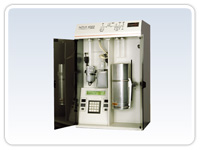Custom Analysis
Specific Surface Area / Pore Distribution
Air Permeability Method (JIS R 5201)

Fill powders in a cell which volume is known, measure transmission time with air volume and pressure kept constant, and calculate specific surface area by comparing to the standard cement.
※For this measurement true specific gravity of powder is needed. We can also measure true specific gravity.
| Analyzer | Blaine Air Permeability Apparatus |
|---|---|
| Measurement Range | Several hundred ~ten thousand cm2/g |
| Sample Amount | About 10 grams |
Gas Adsorption Method
Powders are vacuum deaerated and heat-treated to remove moisture in their pores and surfaces. Putting them in liquid nitrogen and feeding nitrogen gas, nitrogen molecules adsorb on the particle surfaces. Measuring the pressure and the adsorbed amount at that time, the specific surface areas can be calculated.
BET theory 1-point method uses adsorbed amount at a point that relative pressure (saturated vapor pressure and adsorption equilibrium pressure) is 0.25 and multipoint method uses adsorbed amounts at multi points between 0.05~0.35.
| Analyzer | Pore Distribution Analyzer by Gas Adsorption Method NOVA4200e |
|---|---|
| Measurement Range | 0.1m2/g~ |
| Adsorption Gas | N2、Ar、CO2 |
| Pretreatment | Vacuum deaeration and heating (~450℃) |
Pore Distribution
Gas Adsorption Method (BET multipoint method)
After cooling powders, by feeding gas such as nitrogen gas which are insensitive to the powders gas molecules adsorb on the surfaces of particles.The molecules freely moce around the surfaces. As more gas molecules are feeded, the molecules cover the surfaces of powders with a thin membrane.
In actual measurements, gas which molecule surface area is known is used.The number of molecules (Nm) to cover surfaces of powders with monolayer of adsorbed gas can be calculated by BET theory. Surface are a of powders is obtained by multiplying the number of adsorbed molecules (Nm) by cross-section area. As feeding gas after monolayer is built up, individual monolayers pile up to multilayer. At the same time as multilayer is built up, capillary condensation occurs. Whether condensation in pores occurs or not can be determined by observing adsoption amount of gas molecules because a large amount of gas molecules change to liquid.
It is known that the pressure value at condensation is associated with size of pores. In addition, since growth of adsorption amount is proportional to inner volume of pores, pore volume distribution can be known.
| Analyzer | Pore Distribution Analyzer by Gas Adsorption Method NOVA4200e |
|---|---|
| Measurement Range | Specific surface area 0.1m2/g~ Pore distribution 0.00025~0.2μm(2.5~2000Å) |
| Sample Amount | Several grams or more |
| Adsorption Gas | N2、Ar、CO2 |
| Adsorption Gas | Vacuum deaeration and heating (~450℃) |
Mercury Porosimetry
Using the mercury's characteristics of?high surface tension, add pressure in order to spread mercury into pores. This is a method to calculate?specific surface area and pore distribution from the pressure and the amount of injection mercury. Pore sizes are calculated from the pressre. By this method bulk density can be also measureable by spreading mercury in voids and not in pores.
| Analyzer | Mercury porosimetry method pore distribution analyzer PASCAL140/440 |
|---|---|
| Measurement Range | Specific surface area 0.1m2/g~ Pore distribution 0.0034~400μm(34Å~4000000Å) |
| Sample Amount | Several grams or more |